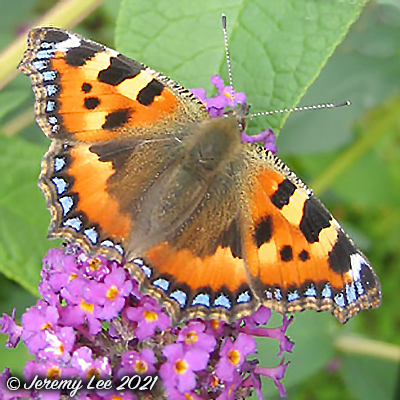
 |
|
Scientific Classifications explained » Amphibians » Ants » Aphids » Bees » Beetles » Birds » Bugs » Butterflies » Caterpillars » Damselflies » Dragonflies » Earwigs » Flies » Frog/Leafhoppers » Fungi » Galls » Grasshoppers » Harvestmen » Hoverflies » Lacewings » Ladybirds » Leaf Mines » Lichens » Mammals » Millipedes » Mosses » Moths » Sawflies » Slugs » Snails » Spiders » Trees & Shrubs » Wasps » Wild Flowers » Woodlice » Postboxes |
UK Nature > Butterflies > Aglais urticae

Scientific Name: Aglais urticae Common Name: Small Tortoiseshell Aglais urticae, more commonly known as the Small Tortoiseshell, is a small and attractive butterfly often seen in gardens, especially feeding on buddleia. Wingspan is about 50mm. The wings are orange with a thin border of brown with small blue dots along the sides. At the front edge of the upper wings there is a pattern of black and yellow or orange marks. The adults drink nectar from flowers such as thistles and buddleia and will very often rest with their wings closed but will open and close them rapidly, flashing their bright colours to confuse and alarm predators. Eggs are usually laid on the common stinging nettle, and the caterpillars are yellow with dense black speckling and two yellow lines down their back and one along each side. They have black spines along their sides and back. They feed on stinging nettle leaves, often spinning leaves together. |
|

https://www.uknature.co.uk is a website dedicated to showing the immense diversity of UK nature and wildlife. Our vast range of habitats, from lowland arable to snow covered mountains, from storm-ravaged coastlines to peaceful inland freshwater lakes and rivers, from dry, sandy heaths to deciduous and coniferous forests, all these habitats contribute to the abundance of UK nature. We have wild birds in huge numbers either residing or visiting our shores (597 recorded species as at July 2013) and we must also not forget the humble back garden with its grass lawns, flower beds filled with nectar rich flowers, shrubs and trees, all designed to attract huge numbers of insects such as bees, moths, butterflies and hoverflies; and finally the small ponds which provide safe havens for frogs, toads, newts and even slow worms and grass snakes. www.uknature.co.uk is the showcase for my personal passion, photographing uknature in all its glory. I sincerely hope you all enjoy the fruits of my labours. This site and all images contained therein is © Jeremy Lee 2004 - 2025. All Rights Reserved. Site design by Jeremy Lee. Site development & IT Support by Stuart Lee. |